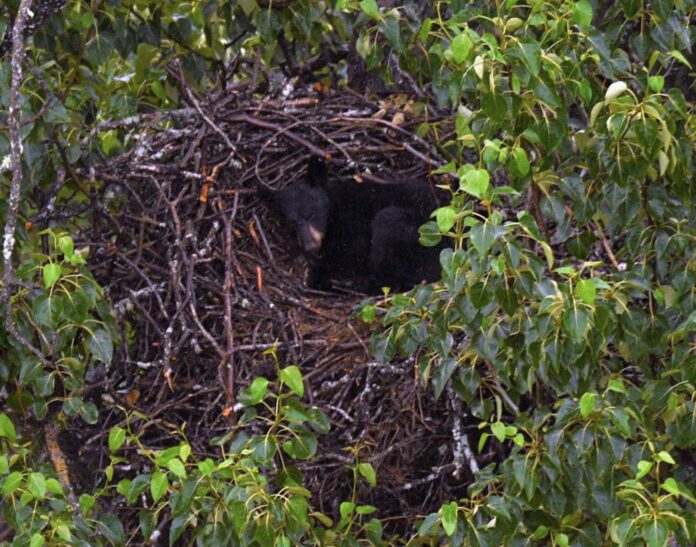An eagle-eyed photographer at Joint Base Elmendorf Richardson snapped a photo of a black bear curled up napping in a bald eagle’s nest on base. The photo was taken during an “eagle productivity survey,” led by Steve Lewis of the United States Fish and Wildlife Service, in partnership with JBER Environmental Conservation.
Whether it’s a bear identifying as an eagle or an eagle identifying as a bear is anyone’s guess these days. It may be just a bear hoping for a little peace and quiet after a full day of fishing, figuring possession of the nest is nine-tenths of the law.
There’s no word on what happened to the eagles or if eggs had been poached by the bear before it took a nap. Alaska bald eagle nests are made from sticks and stalks, and other comfy furnishings like moss and lichen. They usually are 4-6 feet in diameter and 3 feet deep, although they are known to be even larger. Most bald eagles in Alaska have their eggs laid by April, and a clutch can be one to three eggs. Incubation is about 34-36 days, but rarely do all the eggs hatch at once, and it’s not uncommon for only one chick to survive. Seldom are the eggs or chicks left alone, as both male and female eagles incubate the eggs and tend to the fledglings.
Biologists estimate there are as many as 150,000 bald eagles in Alaska and about 100,000 black bears. (And at least one bear who identifies as an eagle.)
Photo Credit: Cayley Elsik, JBER Environmental Conservation

Awesome headline, Suzanne. Thanks for the laugh!!
Black bears are big fans of raiding eagle nests.
Come to think of it, it looks very guilty.
Interesting and entertaining!
I spoke to it by phone yesterday. It identifies as a MatSu cabbage.
Gender undecided at present. It’s weighing its 27,000 choices.
Even wildlife has squatters. He’ll live there for a few weeks, trash the place, then leave.
I once shot a coon out of a squirrel nest. He had a bobbed tail. True story. Funny things happen in the woods.
That’s a special moment.
Quick nap after breakfast.
If you fail to address the bear as an “eagle” it is now a felony and you be fined $10,000
It’s pronouns are “Comfy” and “Eggs Yum!”
No, not beagle. I have one of those!!
Black Bear Lives Matter!
Cute, but in actuality it was probably just returning to make sure it didn’t miss any eggs the first time. Kind of like our representatives.
Great photo op thanks for sharing!
Comments are closed.